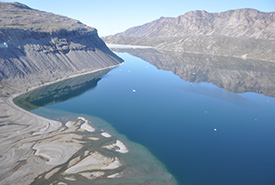Connecting nature

Pond Inlet, Lancaster Sound, NU © Parks Canada/Diane Blanchard
Tallurutiup Imanga National Marine Conservation Area in Nunavut is a shining example of the power of large-scale conservation
By Jimmy Thomson, journalist and freelance writer
Far north of the Arctic Circle — about as far from Ottawa as Ottawa is from Acapulco, Mexico — Canada’s largest National Marine Conservation Area is taking shape. The Tallurutiup Imanga National Marine Conservation Area, formally announced in 2019, will protect some of the planet’s most important habitat for beluga,
polar bear and narwhal from undersea mining and oil and gas exploration — while allowing Inuit to continue their traditional subsistence hunting of those same species. “Inuit wanted this area to be protected because it’s such critical habitat for the wildlife we depend on,” explains Sandra Inutiq, who acted as the chief negotiator for the Qikiqtani Inuit Association as the protected area was being established.
“It really represents a way of life.”
Protecting an area this big, no matter where it is, involves a tremendous level of compromise. The sheer size of the area — 108,000 square kilometres (10,800,000 hectares) — is a monument to the efforts of Inuit, government agencies and conservation organizations that doggedly pursued it for decades.
The Nature Conservancy of Canada (NCC) was among the organizations that played a significant role in facilitating the final boundaries of the National Marine Conservation Area. In 2016, Shell Canada voluntarily released 30 offshore exploratory permits near Tallurutiup Imanga/Lancaster Sound to NCC. Those permits covered more than 8,600 square kilometres (860,000 hectares) north of Baffin Island, at the eastern entrance to the Northwest Passage. NCC subsequently released the permits to the Government of Canada, thereby allowing for expanded boundaries for the marine conservation area to include the full boundary proposed by the Qikiqtani Inuit Association.
This conservation project fits neatly with a philosophy recognizing that the world is running out of areas that are untouched by human industrial development, and that we need to protect and connect large areas of habitat for the benefit of nature and people, including the local Inuit people from Mittimatalik (Pond Inlet), Ikpiarjuk (Arctic Bay) and other nearby communities. Tallurutiup Imanga is an extraordinary win for this new kind of conservation. “We have the ability to play a unique role in helping to make some of the larger conservation projects possible,” explains Kyria Knibb-McLuhan, director of NCC’s Landmark Campaign. “We often end up being a leader or a convener that brings diverse groups together to find innovative conservation solutions.”
When you’re talking about protecting an area the size of Guatemala, you need all the help you can get.
This is an excerpt of a story that first appeared in the winter 2020 issue of the Nature Conservancy of Canada Magazine. Donors who contribute at least $25 or more per year will receive four issues of the magazine. Click here to donate today and start receiving the magazine.



